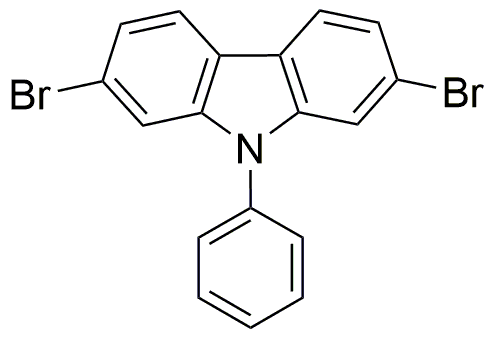2,7-Dibromo-9-phenylcarbazole is widely utilized in research focused on:
- Organic Electronics: This compound is used in the development of organic light-emitting diodes (OLEDs), providing enhanced efficiency and color purity compared to traditional materials.
- Photovoltaics: It serves as a key component in organic solar cells, improving energy conversion efficiency and stability, making it a valuable material for renewable energy applications.
- Fluorescent Dyes: The compound is employed in the formulation of fluorescent dyes for biological imaging, offering superior brightness and photostability for researchers in life sciences.
- Polymer Chemistry: It is utilized in synthesizing novel polymers with tailored electronic properties, aiding in the development of advanced materials for various industrial applications.
- Sensor Technology: This chemical is incorporated into sensors for detecting environmental pollutants, providing high sensitivity and selectivity, which is crucial for environmental monitoring.
Informations générales
Propriétés
Sécurité et réglementation
Applications
2,7-Dibromo-9-phenylcarbazole is widely utilized in research focused on:
- Organic Electronics: This compound is used in the development of organic light-emitting diodes (OLEDs), providing enhanced efficiency and color purity compared to traditional materials.
- Photovoltaics: It serves as a key component in organic solar cells, improving energy conversion efficiency and stability, making it a valuable material for renewable energy applications.
- Fluorescent Dyes: The compound is employed in the formulation of fluorescent dyes for biological imaging, offering superior brightness and photostability for researchers in life sciences.
- Polymer Chemistry: It is utilized in synthesizing novel polymers with tailored electronic properties, aiding in the development of advanced materials for various industrial applications.
- Sensor Technology: This chemical is incorporated into sensors for detecting environmental pollutants, providing high sensitivity and selectivity, which is crucial for environmental monitoring.
Documents
Fiches de données de sécurité (FDS)
La FDS fournit des informations de sécurité complètes sur la manipulation, le stockage et l’élimination du produit.
Spécifications du produit (PS)
Le PS fournit une description complète des propriétés du produit, notamment sa composition chimique, son état physique, sa pureté et les exigences de stockage. Il détaille également les plages de qualité acceptables et les applications prévues du produit.
Certificats d'analyse (COA)
Recherchez des certificats d'analyse (COA) en saisissant le numéro de lot du produit. Les numéros de lot et de lot se trouvent sur l'étiquette d'un produit, après les mots « Lot » ou « Lot de fabrication ».
Numéro de catalogue
Numéro de lot/série
Certificats d'origine (COO)
Ce certificat d'exploitation confirme le pays dans lequel le produit a été fabriqué, et détaille également les matériaux et composants utilisés et s'il est issu de sources naturelles, synthétiques ou autres sources spécifiques. Ce certificat peut être requis pour les douanes, le commerce et la conformité réglementaire.
Numéro de catalogue
Numéro de lot/série
Fiches de données de sécurité (FDS)
La FDS fournit des informations de sécurité complètes sur la manipulation, le stockage et l’élimination du produit.
DownloadSpécifications du produit (PS)
Le PS fournit une description complète des propriétés du produit, notamment sa composition chimique, son état physique, sa pureté et les exigences de stockage. Il détaille également les plages de qualité acceptables et les applications prévues du produit.
DownloadCertificats d'analyse (COA)
Recherchez des certificats d'analyse (COA) en saisissant le numéro de lot du produit. Les numéros de lot et de lot se trouvent sur l'étiquette d'un produit, après les mots « Lot » ou « Lot de fabrication ».
Numéro de catalogue
Numéro de lot/série
Certificats d'origine (COO)
Ce certificat d'exploitation confirme le pays dans lequel le produit a été fabriqué, et détaille également les matériaux et composants utilisés et s'il est issu de sources naturelles, synthétiques ou autres sources spécifiques. Ce certificat peut être requis pour les douanes, le commerce et la conformité réglementaire.


